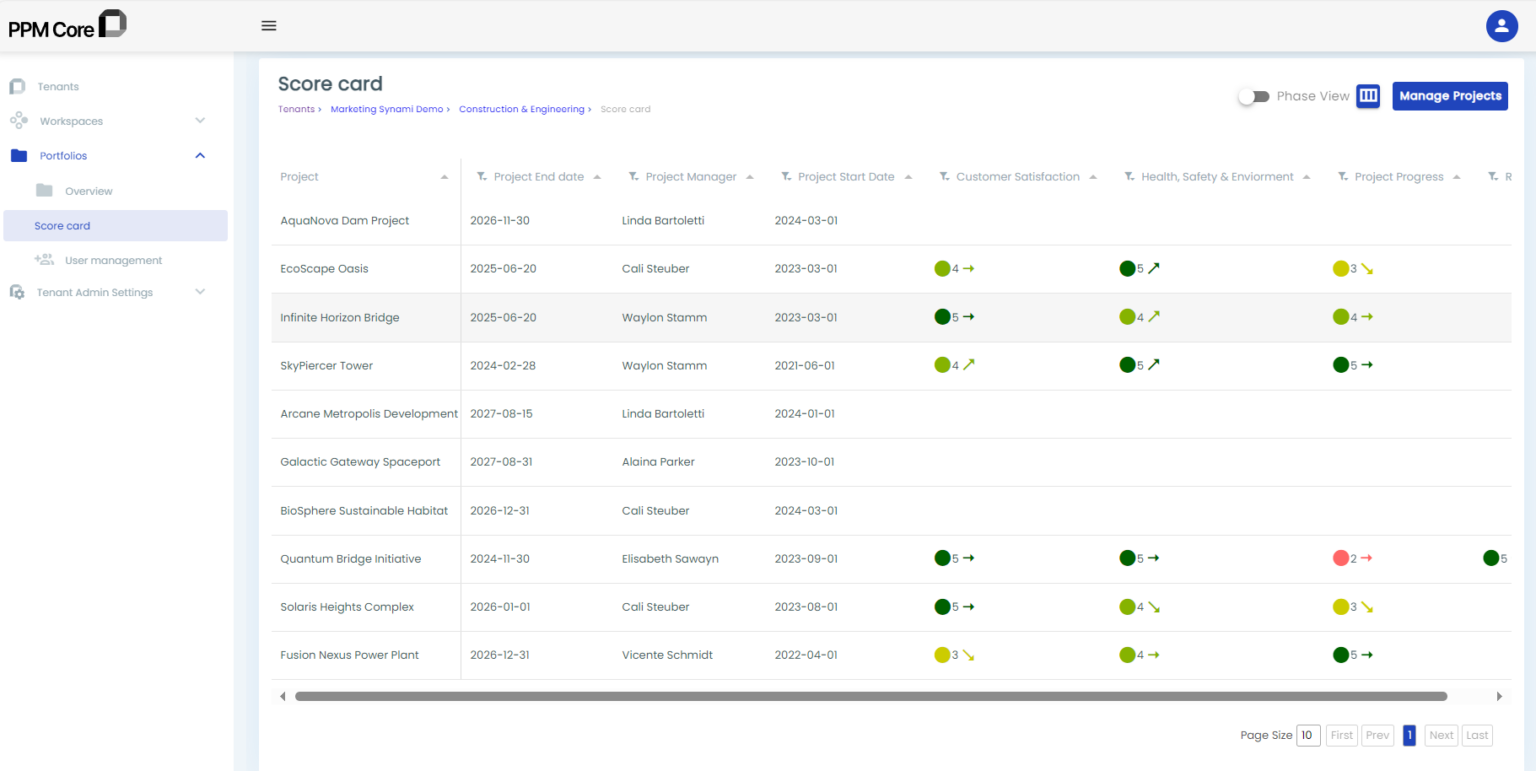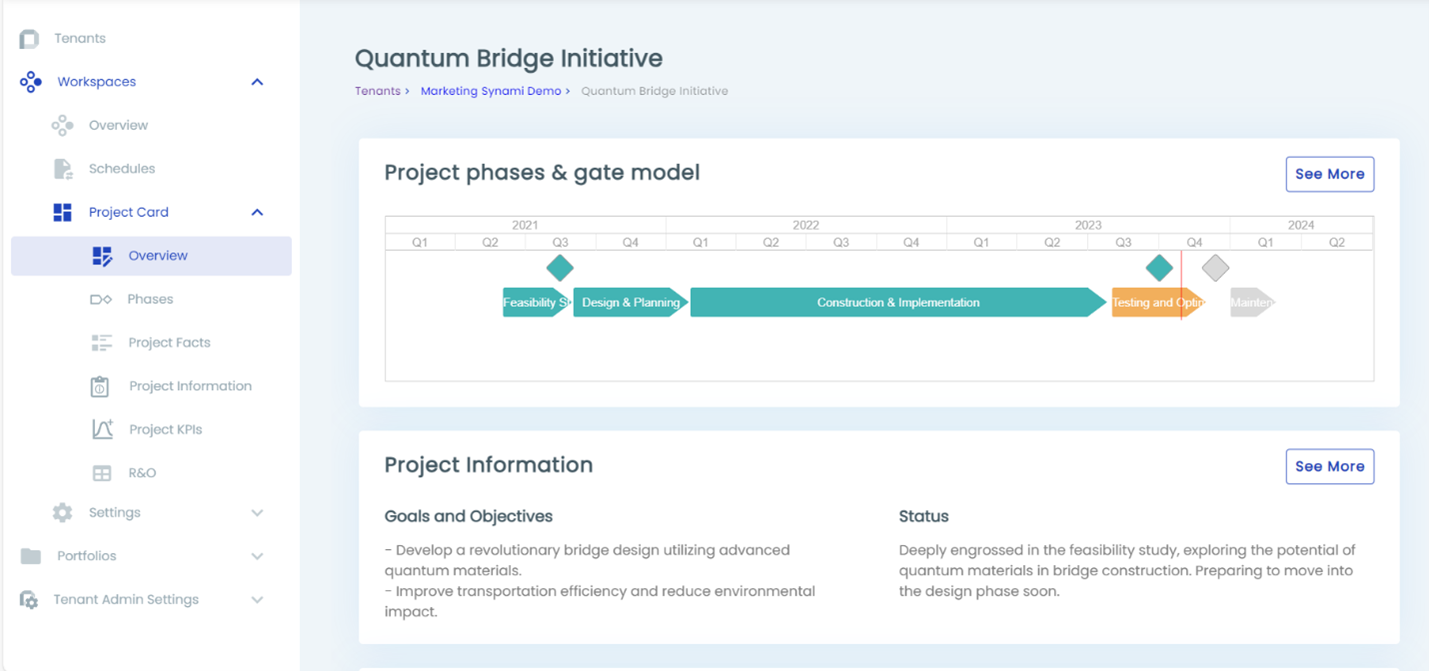Project portfolio management (PPM) is the process of analyzing and optimizing the costs, resources, technology, and processes associated with all projects that are grouped into one set known as portfolio. In other words, portfolio is a set of projects and programs, while program is a set of several projects. Project portfolio management is often handled by portfolio managers or a project management office (PMO).
The primary objective of PPM is to ensure that all portfolio outcomes align with the organization’s strategic goals and business objectives. Therefore, the project portfolio manager, or PMO, accomplishes this by conducting business analysis, reviewing budgets, and forecasting while mitigating risk and managing stakeholder expectations.
Project portfolio management gives organizations and managers the ability to see the big picture.
- Executives – know what project managers to reach
- Portfolio Managers – can proactively manage the project changes and risks in the portfolio
- CFO, COO (C levels officers) – can optimize the project portfolio to deliver strategic initiatives
Project Portfolio Management is defined as a discipline that focuses on completing the proper projects at the right time through project selection and management. It is intended to help companies allocate their limited number of resources and funds to the most valuable projects to make their strategic goals achievable.
Strategic Portfolio Management creates the framework for success for an organization by identifying the investments needed to achieve the business’ goals and objectives.
In the following section, we will examine the key components of the Project Portfolio Management process and provide a detailed guide to optimizing project selection, prioritizing, and project execution.
Key elements of the Project Portfolio Management Process
There are several key elements to PPM, all of which have to be effective for PPM to succeed:
- Defining business objectives: Clarifying business objectives is a critical first step in project portfolio management. According to Harvard Business Review, articulating a common definition aligns teams with a singular purpose, and without purpose, teams lack the motivation to tackle challenges that prevent the organization from achieving its goals.
- Portfolio governance: This is a lean approach that provides effective leadership control while allowing teams the flexibility to deliver in ways that work best for them.
- Resource management: It requires a detailed understanding of current and forecast resourcing needs, identification of gaps and established approaches to resolve while balancing skills and resources.
- Cost management: Provides clear and complete visibility into planned, actual, and forecast costs combined with the ability to understand and manage variables across all initiatives.
- Schedule management & roadmaps: Ensures all current and upcoming work is scheduled in alignment with organizational strategies, delivering the right work at the right time while understanding and managing for all dependencies across all portfolios and investment types.
- In the context of a project, Collaboration entails assembling a team from several departments, offices, businesses, and countries to fulfill a task. In recent years, the vast number of tools and technologies accessible has driven the desire for collaboration. Teams can now communicate, share and co-edit documents, assign work, create reports, automate activities using workflows, and do much more at any time and from any location.
- Status reporting: Complete, timely, automated status updates provide contextualized information to different stakeholder groups with the ability to drill down to whatever level of detail is required.
By utilizing the key elements of project portfolio management, organizations can more easily and confidently:
- Prioritize projects with the greatest strategic alignment and the most potential value.
- Increase project delivery success.
- Decrease overspends and inefficiencies .
- Make smarter decisions.
- Manage change effectively.
What types of Industries and companies benefit from Project Portfolio Management?
The fact is that collaboration becomes increasingly difficult as a company grows. For businesses like Civil Industry, Oil and Gas, or Construction, this presents to be a huge challenge as their capacity to grow depends on the size and number of projects they can accomplish. Modern challenges require modern solutions, which is why it is good that there are digital solutions when it comes to project management as well.
The Role of the Portfolio Manager
Project(s) portfolio is used mostly by the portfolio managers for controlling how the company’s portfolio aligns with the company’s OKRs, mission, and financial goals. Properly aligned portfolios can bring benefits to the entire company.
How can PPM Core connect teams and members in Organizations?
PPM Core as a project portfolio management platform is designed to empower project-oriented companies and organizations.
Through its Portfolio Management feature, the platform provides an overview of all projects within a portfolio and allows users to easily monitor project performance and compare progress against planned data.
The goal of this feature is to gather better insights into the project’s status, progress, and execution by analyzing, prioritizing, and organizing the data, giving managers and teams the ability to collect data in one place and make informed project decisions.
Project Portfolio Management and Business Strategy
Aligning business strategy with project portfolio management (PPM) is critical for any company looking to improve its operations and achieve its goals. This approach offers numerous benefits that cover a wide range of company functions. These alignments allow businesses to streamline their projects and improve resource allocation, risk management, and productivity.
How can PPM Core help Project Portfolio Managers improve and ease their decision-making?
PPM Core enables companies to align their project initiatives with business goals and objectives by providing a systematic approach to managing project portfolios. It allows organizations to prioritize projects, allocate resources strategically, and monitor project performance to ensure successful outcomes. Additionally, PPM Core plays a vital role in enhancing decision-making processes, mitigating risks, and maximizing the value of projects.
PPM Core is designed to help portfolio managers with their extensive number of tasks, including:
- Streamline all schedules in one location (enhanced accessibility).
- Manage the scope, resources, and execution of projects with ease (Efficient Resource Management and visibility into entire project pipeline).
- Strategically design and optimize project portfolios. (Providing a clear picture of the project’s current condition, effective decision-making)
Challenges of PPM and how to address them
Project activities can be affected by various business domains and challenges for the whole duration of the project and requires the contribution of many different teams, tools, and systems to respond to those threats accordingly and effectively.
When it comes to addressing the most important challenges for organizations, the emphasis falls on:
Lack of Visibility and Transparency
One of the primary challenges in Project Portfolio Management is the lack of visibility and transparency across projects. Without a clear view of all ongoing projects and their status, project managers may struggle to make data-driven informed decisions.
Additionally, stakeholders may become disengaged due to the inability to track progress accurately. To address this challenge, project managers can implement robust reporting mechanisms and utilize PPM Software solutions that offer real-time dashboards.
These tools provide stakeholders with visibility into project progress, resource allocation, and budget utilization, fostering transparency and accountability throughout the project portfolio.
Resource Management

Do you find this article interesting?
Subscribe to our Newsletter for updates on the latest blog articles.
Efficient resource management is critical to the successful completion of projects within a portfolio. However, resource limits, competing agendas, and inadequate planning frequently present substantial obstacles for project managers. Improper resource allocation can cause project delays, cost overruns, and quality difficulties.
To address this difficulty, project managers should take a strategic approach to resource management. This comprises recognizing resource requirements early in the project life cycle, maximizing resource consumption, and leveraging PPM tools for resource allocation and tracking.
Aligning resources with project objectives improves productivity and reduces obstacles.
Measuring and reporting value and performance
When there are no defined or agreed-upon measurements, techniques, or standards for measuring and reporting portfolio value and performance, it can be difficult to establish the portfolio’s contribution, impact, or success.
To overcome this challenge, you need to define and align the value and performance indicators with the strategic goals and objectives and use a balanced scorecard or a dashboard to track and display the portfolio’s progress and results.
By addressing these challenges proactively and leveraging advanced PPM software solutions, organizations can enhance their project management capabilities, drive innovation, and gain a competitive edge in today’s dynamic business landscape.
Best practices to maximize Project Portfolio full potential
Optimization of portfolios
Portfolio managers are often under pressure to generate business value quickly. This sense of urgency can lead to a focus on project completion rather than portfolio optimization. While this approach may provide short-term benefits to the organization, it may also present difficulties in the future. It is critical that portfolio management considers the full cycle :
- Collect
- Categorize
- Identify
- Prioritize
- Select
- Authorize
- Review projects
Governance
The success of project portfolio management is related to a quick and accurate assessment of external business elements such as competitor actions, innovative technology and engineering, governmental requirements, and shifts in customer preferences and lifestyle.
While most businesses begin portfolio management on a positive note, the accuracy of long-term governance struggles for many reasons.
Project portfolio management software with comprehensive analytics, business rules-driven alerts, notifications, and real-time collaboration simplifies the process of governance.
Implementing a Risk management strategy
The effectiveness of project portfolio management is heavily dependent on the assessment of external factors and their impact on portfolio goals and objectives.
Most project portfolio managers face a decision-making challenge because they lack adequate and up-to-date insights.
That’s why systematic approaches must be in place to provide project portfolio managers with appropriate insights, analytics, and notifications.
Conclusion
To summarize, Project Portfolio Management (PPM) is the strategic foundation that organizations rely on to overcome complexity and achieve their goals. By connecting projects with overarching goals, maximizing resources, controlling risks, and encouraging adaptation, PPM ensures that companies can remain successful in an environment of rapid change. It is a critical framework for increasing efficiency, fostering innovation, and providing value to stakeholders.
The PPM Core project portfolio management platform can assist in establishing this much-needed framework by offering teams and organizations one unified place to manage all project operations, collaborate, and successfully handle complex projects.
It provides a possibility to analyze and prioritize projects using the Project Score card and The Phase-Gate view. Users get many benefits among which are:
- Highlights of projects along with measurable KPIs (Key Performance Indicators) to allow monitoring and comparison of project’s progress and performance.
- Intuitive filter and sort functions that allow full flexibility in presenting data.
- Option to create Potential projects and see what kind of impact they have on your portfolio.
The integrated phase-gate model allows project managers to view project timelines and provides clear visibility of progress and key elements, supports effective decision-making, and helps prioritize projects. Through this method, project managers gain better control over execution and clear insights into current stages and overall progress.
Optimize Your Projects with PPM Core: Schedule a demo today and see how our project portfolio management platform can streamline your workflows: http://ppmcore.com/book-a-demo




